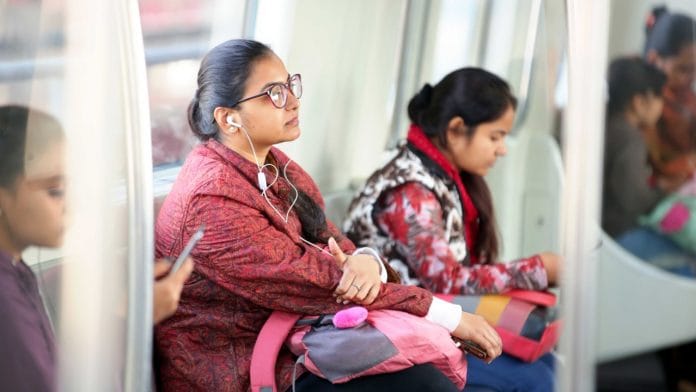For some weeks now, Delhi’s Arvind Kejriwal government has been in the ‘unlock everything’ mode — offices, malls, shopping complexes, and bus services. But only after the Delhi Metro announced that it might reopen in September does it really feel like the national capital will truly be unlocked. That is when we can demonstrate that the city really has learned to live with the coronavirus, as the cliché goes.
Delhi isn’t moving until its Metro is running – that is how the last 18 years have changed the city. If ‘normal’ life in a pandemic is to be imagined, it can’t be without the Delhi Metro. It is much more than just an efficient system of urban commute, it is a class unifier, it boosts women’s freedom of mobility and safety, it is a successful experiment in how Delhi’s residents can be taught not to litter and be swachch, and many of its stations are art galleries.
Delhi Metro is a glimpse into what Delhi-ites can potentially be.
With the Metro, it used to feel like New Delhi was always moving. Even on national holidays such as Independence Day or Holi, Metro services were barely shut for a few hours. When there were unforeseen circumstances like violent protests or bandhs, only select Metro stations were temporarily closed. But in March, when the Delhi government declared a week-long lockdown, followed by Prime Minister Narendra Modi’s announcement of a nationwide 21-day lockdown, it was clear the pandemic was going to change the way our cities functioned. And the way we inhabited them.
The shared economy as we once knew it, is apparently over, and analysts say the current moment is all about the ‘isolation’ economy. The opening of the Metro will be the real test of this, and will indicate whether the Covid-cautious middle-class will ditch public transport to stick to their cushy-bubbles of private vehicles, Ubers, Olas, to buses.
Also read: Why Covid gives Delhi the perfect reason & chance to revamp its public transport system
An incomplete city
For many, travelling in the Metro was not just about a daily ‘commute’ — a mundane term that conjures up the same exhaustion that Mondays do. It was also about daily rituals. Everyone had a Metro companion: a book, an iPod, a phone screen, or an actual friend. Each had preferred ways of being productive during their travel time — watching Netflix, revising for an exam, reading the morning news, catching up on a meal. Or some, like me, just chose to people-watch.
I enjoyed observing commuters excitedly chatting with their co-workers and classmates who were heading in the same direction, bag-laden aunties returning from Lajpat or Sarojini Nagar shopping trips, and then asking everyone to ‘adjust’ for a seat. I have invariably eavesdropped on loud phone conversations, anything from fights with boyfriends to job interviews. I have surreptitiously taken pictures of interesting shoes and bags I spotted, tucking the images away for a later moment when I might need a flash of fashion inspiration. But with all offices, colleges, schools, moving into our homes, that slice of everyday life one got to experience was suddenly gone. While ruminating about pre-Covid days, many have confessed to me how much they miss the Metro. Not only the easy mobility it offered, but also the ability to be around strangers and silently co-exist, without nervously adjusting one’s face mask and worrying about maintaining sufficient distance.
When the pandemic first ‘struck’, the city went quiet. Now things are seemingly back to normal — roads are clogged with traffic, people are hurrying past street corners, pavements are lined with paan stains again. But Metro stations, which dotted the length and breadth of the city, are silent and desolate. Once the nucleus of activity, attracting people, auto-rickshaws, street food vendors, and panwaadis, the defunct stations now serve as a taunting reminder that we are still in a pandemic.
Also read: Replace drivers with automated systems — how to make mobility safe during Covid crisis
Metro as a unifier
My friend once told me that he saw Congress leader Sachin Pilot get on to the Metro for a few stops, presumably to skip a bad patch of traffic. Prime Minister Narendra Modi, too, has on occasion traveled by the Metro during peak hour. This should not be surprising — what’s wrong with elected representatives using public transport along with the rest of us? But sadly, that’s not how things work in India, where the rich and powerful do not usually mingle with the masses when it comes to transport choices.
Since its inauguration in 2002, the Metro has become synonymous with public transport and affordable mobility in New Delhi. But more importantly, it has also been a unifying force in a city highly divided by class, bringing together nearly 15 lakh daily passengers from different backgrounds, belonging to different corners of the ever-expanding city.
The coronavirus pandemic brought inequality into sharp focus — social distancing, working-from-home, and job security have been luxuries reserved for a few. This inequality could potentially spill onto the way we travel. Yet, the bated anticipation with which Delhi-ites await the reopening of the Metro shows that it is our lifeline, and it is crucial to truly ‘unlock’ our city.
Views are personal.






